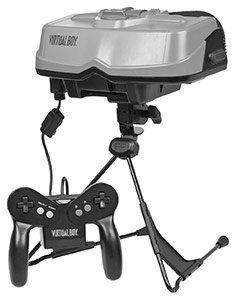Gaming The System: Holodorks: VR today and yesterday
 CREDIT: NINTENDO
CREDIT: NINTENDOThe Virtual Boy was a video game console marketed as having virtual reality graphics and didn�t last two years in the market.
Virtual reality has probably been the most unstable of gaming developments, with roller-coaster-like public interest and squabbling companies hiding away patents, filing lawsuits and striking each other down left and right. The initial skepticism towards the announcement and funding requests of the Occulus Rift in 2012 was indeed justifiable, as literally no one up to that point had made a truly successful virtual reality (as in, full visual immersion, rather than plain wearable displays) experience.
And as we all know, the Occulus Rift blew away those who tested it. Featuring accelerometer-based head movement tracking and a visual display that did not futz the wearer's eyes out in minutes, the Rift has jumpstarted a renewed interest in the realm of virtual reality. It almost seems like technology needed to reach a certain apex to make all the elements of VR come together in a feasible manner, doesn't it? Yet for how amazing and boundary pushing this young yet expanding market is, past failures are just, plainly put, entertaining for all the wrong reasons.
VFX1 Head Mounted Display (1995)
This granddaddy to the Occulus Rift was one of the most advanced head-mounted displays on the market of 1995. Yet, it didn't gain much ground. Even its own technical shortcomings aside (despite its impressive tech), the market simply wasn't ready for an actual VR gaming experience. Well, less the market and more the game developers. You need to remember that 1995 was the year Quake brought computers to their knees for want of processing power. At the very most, it could be used as a wearable TV without fancy head tracking. And that apparently wasn't worth wearing a bulky, silly-looking device. Like all weirdly niche ‘90s products, it still enjoys cult popularity and has fan-made drivers for modern PCs.
Virtual Boy (1996)
Oh yes, this bad boy has made it into my column more than once in the past. Being a personal owner of one (don't ask me how), I can definitely attest to all the claims of what makes this completely-not-portable gaming system a bomb. Even putting aside the monochrome red-black display which entirely negates the point of VR, the Virtual Boy's 3D display was awesomely eye-straining, as a result of the visuals appearing as a persistent foreground, thus forcing the eyes to focus on them to the point of muscle fatigue. Failed VR experiment AND a dark stain on Nintendo's then clean track record.
Sega Activator (1993)
Not all VR focused on trying to kill your eyes in the name of immersion. The Sega Activator theoretically intended to introduce a degree of interaction between the gamer and his game. Instead, what kids spoiled enough to receive this got was an octagonal piece of plastic that supposedly used infrared tracking to simulate button presses, but only when it felt like it as they stood in the centre, flailing their arms like paratroopers without parachutes.
EyeToy (2005)
This PS2 accessory was a precursor to the Kinect and took on the realm of “augmented reality” (i.e. the computer virtually interacting with an environment) that made users look even dorkier than its successor. For all the Kinect's shortcomings as a gameplay device, it is truly impressive from a technical standpoint. The Sony Eyetoy... is not. The initial novelty of seeing oneself in the game world quickly wore off when games were simply variations of make the motion of picking/hitting/ awkwardly interacting with this thing on the TV.













